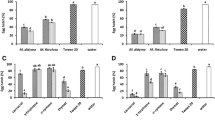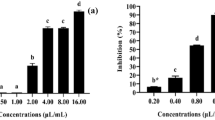Abstract
Plant parasitic nematodes are the most destructive group of plant pathogens worldwide and their control is extremely challenging. Plant Essential oils (EOs) and their constituents have a great potential in nematode control since they can be developed for use as nematicides themselves or can serve as model compounds for the development of derivatives with enhanced activity. This study reviews the plant EOs evaluated as potential nematicides and their toxic effects against pinewood nematode (Bursaphelenchus xylophilus) and root-knot nematodes (Meloidogyne spp.). Additionally, the nematicidal activity to M. javanica of several EOs from Spanish aromatic plants and their components is described.

Similar content being viewed by others
Abbreviations
- EOs:
-
Essentials oils
- J2:
-
Second-stage juveniles of Meloidogyne spp
- GC-MS:
-
Gas chromatography-mass spectrometry
- GABA:
-
Gamma-aminobutyric acid
- AChE:
-
Acetylcholinesterase
References
Adekunle OK, Acharya R, Singh B (2007) Toxicity of pure compounds isolated from tagetes minuta oil to meloidogyne incognita. Australas Plant Dis Notes (AUS) 2:101–104
Al-Banna L, Darwish RM, Aburjai T (2003) Effect of plant extracts and EOs on root-knot nematode. Phytopathol Mediterr 42:123–128
Albuquerque MRJR, Costa SMO, Bandeira PN, Santiago GMP, Andrade-Neto M, Silveira ER (2007) Nematicidal and larvicidal activities of the EOs from aerial parts of pectis oligocephala and pectis apodocephala baker. An Acad Bras Cienc 79:209–213
Bakkali F, Averbeck S, Averbeck D, Idaomar M (2008) Biological effects of EOs-a review. Food Chem Toxicol 46:446–475
Barbosa P, Lima AS, Vieira P, Dias LS, Tinoco MT, Barroso JG (2010) Nematicidal activity of EOs and volatiles derived from portuguese aromatic flora against the pinewood nematode, Bursaphelenchus xylophilus. J Nematol 42:8–16
Batish DR, Singh HP, Kohli RK, Kaur S (2008) Eucalyptus essential oil as a natural pesticide. For Ecol Manag 256:2166–2174
Bird DMcK, Williamson VM, Abad P, McCarter J, Danchin EGJ (2009) The genome of root-knot nematodes. Ann Rev Phytopathol 47:333–351
Bleve-Zacheo T, Melillo MT, Castagnone-Sereno P (2007) The contribution of biotechnology to root-knot nematode control in tomato plants. Pest Tech 1:1–16
Buchbauer G (2000) The detailed analysis of EOs leads to the understanding of their properties. Perfumer Flavorist 25:64–67
Burillo J, García-Vallejo MC (2003) Investigación y Experimentación de Plantas Aromáticas y Medicinales en Aragón. Cultivo, Transformación y Analítica. Ed. propagation activities of thyme red and whiteGobierno de Aragón
Castagnone-Sereno P (2006) Genetic variability and adaptative evolution in parthenogenetic root-knot nematodes. Heredity 96:282–289
Cayrol JC, Djian C, Pijarowski L (1989) Study of the nematocidal properties of the culture filtrate of the nematophagous fungus Paecilomyces lilacinus. Rev Nematol 12:331–336
Chitwood DJ (2002) Phytochemical based strategies for nematode control. Ann Rev Phytopathol 40:221–249
Choi IH, Kim J, Shin SC, Park IK (2007a) Nematicidal activity of monoterpenoids against the pine wood nematode (Bursaphelenchus xylophilus). Russ J Nematol 15:35–40
Choi I, Park J, Shin S, Kim J, Park I (2007b) Nematicidal activity of medicinal plant EOs against the pinewood nematode (Bursaphelenchus xylophilus). Appl Entomol Zool 42:397–401
Choi IH, Shin SC, Park IK (2007c) Nematicidal activity of onion (Allium cepa) oil and its components against the pine wood nematode (Bursaphelenchus xylophilus). Nematology 9:231–235
Chuan QB, Zhi LL, Qi ZL (2011) Nematicidal constituents from the essential oil of Chenopodium ambrosioides aerial parts. E-J Chem 8:143–148
Douda O, Zouhar M, Mazáková J, Nováková E, Pavela R (2010) Using plant essences as alternative mean for northern root-knot nematode (Meloidogyne hapla) management. J Pest Sci 83:217–221
Echeverrigaray S, Zacaria J, Beltrão R (2010) Nematicidal activity of monoterpenoids against the root-knot nematode Meloidogyne incognita. Phytopathology 100:199–203
Elbadri GAA, Lee DW, Park JCH, Yu HB, Choo HY, Lee SM, Lim TH (2008) Nematocidal screening of essentials oils and herbal extracts against Bursaphelenchus xylophilus. Plant Pathol J 24:178–182
Gupta A, Sharma S, Naik SN (2011) Biopesticidal value of selected EOs against pathogenic fungus, termites, and nematodes. Int Biodeter Biodegr 65:703–707
Isman MB, Miresmailli S, Machial C (2011) Commercial opportunities for pesticides based on plant EOsin agriculture, industry and consumer products. Phytochem Rev 10:197–204
Joy PP, Thomas J, Mathew S, Jose G, Joseph J (2001) Aromatic plants. In: Bose TK, Kabir J, Das P, Joy PP (eds) Tropical horticulture, vol 2. Naya Prokash, Calcutta, pp 633–733
Kaur S, Rana S, Singh HP, Batish DR, Kohli RK (2011) Citronellol disrupts membrane integrity by inducing free radical generation. Z Naturforsch C 66:260–266
Kim J, Seo S, Lee S, Shin S, Park I (2008) Nematicidal activity of plant EOs and components from coriander (Coriandrum sativum), oriental sweetgum (Liquidambar orientalis), and valerian (Valeriana wallichii) EOs against pine wood nematode (Bursaphelenchus xylophilus). J Agric Food Chem 56:7316–7320
Kim J, Seo S, Park I (2011) Nematicidal activity of plant EOs and components from gaultheria fragrantissima and zanthoxylum alatum against the pine wood nematode, Bursaphelenchus xylophilus. Nematology 13:87–93
Kok CJ, Papert A, Hok-A-Hin CH (2001) Microflora of Meloidogyne egg masses: species composition, population density and effect on the biocontrol agent Verticillium chlamydosporium (Goddard). Nematology 3:729–734
Kong J, Lee S, Moon Y, Lee S, Ahn Y (2006) Nematicidal activity of plant EOsagainst Bursaphelenchus xylophilus (Nematoda: aphelenchoididae). J Asia Pac Entomol 9:173–178
Kong J, Park I, Choi K, Shin S, Ahn YJ (2007) Nematicidal and propagation activities of thyme red and white oil compounds toward Bursaphelenchus xylophilus (Nematoda: parasitaphelenchidae). J Nematol 39:237–242
Kostyukosky M, Chen B, Atsmi S, Shaaya E (2000) Biological activity of two juvenoids and two ecdysteroids against three stored product insects. Insect Biochem Mol Biol 30:891–897
Koul O, Walia S, Dhaliwal GS (2008) EOs as green pesticides: potential and constraints. Biopesti Int 4:63–84
Krueger R, Dover KE, McSorley R (2007) Marigold (Tagetes spp.) for nematode management. ENY-056 (NG045), Entomology and Nematology Department, Florida Cooperative Extension Service, Institute of Food and Agricultural Sciences, University of Florida, Gainesville, FL
Lahlou M (2004) Methods to study the phytochemistry and bioactivity of essential oils. Phytother Res 18:435–448
Lahlou M, Berrada R (2003) Composition and niticidal activity of EOs of three chemotypes of Rosmarinus officinalis L. acclimatised in Morocco. Flav Frag J 18:124–127
Lambert RJ, Skandamis PN, Coote PJ, Nychas GJ (2001) A study of the minimum inhibitory concentration and mode of action of oregano essential oil, thymol and carvacrol. J Appl Microbiol 91:453–462
Lee SE, Lee BH, Choi WS (2001) Fumigant toxicity of volatile natural productsfrom Korean spices and medicinal plants towards the rice weevil. Pest Manag Sci 57:548–553
Leela NK, Khan RM, Reddy PP, Nidiry ESJ (1992) Nematicidal activity of essential oil of Pelargonium graveolens against the root-knot nematode Meloidogyne incognita. Nematol Medit 20:57–58
Lei J, Leser M, Enan E (2010) Nematicidal activity of two monoterpenoids and SER-2 tyramine receptor of Caenorhabditis elegans. Biochem Pharmacol 79:1062–1071
Li HQ, Bai ChQ, Chu SS, Zhou L, Du SS, Liu ZL, Liu QZ (2011) Chemical composition and toxicities of the essential oil derived from Kadsura heteroclita stems against Sitophilus zeamais and Meloidogyne incognita. J Med Plant Res 5:4943–4948
Marino RH, Gomes LAA, Cruz EMO, Silva AC, Bianchini FG, Meneses TN, Santos HR, Blank AF (2012) Controle de Meloidogyne incognita raça 1 com óleo esencial de Lippia Alba. Sci Plena 8:04021
Martín A, Varona S, Navarrete A, Cocero MJ (2010) Encapsulation and coprecipitation processes with supercritical fluids: applications with essential oils. Open Chem Eng J 4:31–41
Meyer SLF, Lakshman DK, Zasada IA, Vinyard BT, Chitwood DJ (2008) Dose-response effects of clove oil from Syzygium aromaticum on the root-knot nematode Meloidogyne incognita. Pest Manag Sci 64:223–229
Moreira FJC, Santos CDG, Innecco R (2009) Hatching and mortality of second-stage juveniles of Meloidogyne incognita race 2 in essential plant oils. Rev Cienc Agron 40:441–448
Ntalli NG, Ferrari F, Giannakou I, Menkissoglu-Spiroudi U (2010) Phytochemistry and nematicidal activity of the EOs from 8 greek lamiaceae aromatic plants and 13 terpene components. J Agric Food Chem 58:7856–7863
Ntalli NG, Ferrari F, Giannakou I, Menkissoglu-Spiroudi U (2011) Synergistic and antagonistic interactions of terpenes against Meloidogyne incognita and the nematicidal activity of EOs from seven plants indigenous to Greece. Pest Manag Sci 67:341–351
Nyczepir AP, Thomas SH (2009) Current and future management strategies in intensive crop production systems. In: Perry RN, Moens M, Starr JL (eds) Root-knot nematodes. CABI, United Kingdom, pp 412–443
Oka Y (2001) Nematicidal activity of essential oil components against the root-knot nematode Meloidogyne javanica. Nematology 3:159–164
Oka Y, Nacar S, Putievsky E, Ravid U, Yaniv Z, Spiegel Y (2000) Nematicidal activity of EOs and their components against the root-knot nematode. Phytopathology 90:710–715
Onifade AK, Fatope MO, Deadman ML, Al-Kindy SMZ (2008) Nematicidal activity of Haplophyllum tuberculatum and Plectranthus cylindraceus oils against Meloidogyne javanica. Biochem Syst Ecol 36:679–683
Orion D, Kritzman G, Meyer SL, Erbe EF, Chitwood DJ (2001) A role of the gelatinous matrix in the resistance of root-knot nematode (Meloidogyne spp.) eggs to microorganisms. J Nematol 33:203–207
Pandey R, Kalra A, Tandon S, Mehrotra N, Singh HN, Kumar S (2000) EOs as potent sources of nematicidal compounds. J Phytopathol 148:501–502
Park I, Park J, Kim K, Choi K, Choi I, Kim C (2005) Nematicidal activity of plant EOs and components from garlic (Allium sativum) and cinnamon (Cinnamomum verum) oils against the pine wood nematode (Bursaphelenchus xylophilus). Nematology 7:767–774
Park I, Kim J, Lee S, Shin S (2007) Nematicidal activity of plant EOs and components from ajowan (Trachyspermum ammi), allspice (Pimenta dioica) and litsea (Litsea cubeba) EOs against pine wood nematode (Bursaphelenchus xylophilus). J Nematol 39:275–279
Pérez MP, Navas-Cortés JA, Pascual-Villalobos MJ, Castillo P (2003) Nematicidal activity of EOs and organic amendments from asteraceae against root-knot nematodes. Plant Pathol 52:395–401
Priestley CM, Williamson EM, Wafford KA, Sattelle DB (2003) Thymol, a constituent of thyme essential oil, is a positive allosteric modulator of human GABAA receptors and a homooligomeric GABA receptor from Drosophila melanogaster. Brit J Pharmacol 140:1363–1372
Salgado SLM, Campos VP, Cardos MDG, Salgado APS (2003) Hatching and mortality of second-stage juveniles of Meloidogyne exigua in essential plant oils. Nematol Brasil 27:17–22
Sangwan NK, Verma KK, Verma BS, Malik MS, Dhindsa KS (1985) Nematicidal activity of EOs of Cymbopogon grasses. Nematologica 31:93–99
Saxena DB, Goswami BK, Tomar SS (1987) Nematicidal activity of some EOs against Meloidogyne incognita. Indian Perfume 31:150–154
Sinha A, Maheshwari RC, Dureja P, Mojumder V (2006) Nematicidal activity of EOs and their components against the root-knot nematode Meloidogyne incognita. Indian J Nematol 36:109–114
Sorribas J, Ornat C (2011) Estrategias de control integrado de nematodos fitoparásitos. In: Andrés MF, Verdejo S (eds) Enfermedades causadas por nematodos fitoparásitos en España. Phytoma-SEF. Valencia, pp 115–127
Sosa ME, Lancelle HG, Tonn CE, Andres MF, Gonzalez-Coloma A (2012) Insecticidal and nematicidal EOs from Argentinean Eupatorium and Baccharis spp. Biochem Syst Ecol 43:132–138
Torres MC, Assunçao JC, Santiago GMP, Andrade-Neto M, Silveira ER, Costa-Lotufo LV, Bezerra DP, Marinho-Filho JD, Viana FA, Pessoa L (2008) Larvicidal and nematicidal activities of the leaf essential oil of Croton regelianus. Chem Biodivers 5:2724–2728
Tsuchiya H (2001) Biphasic membrane effects of capsaicin, an active component in Capsicum species. J Ethnopharmacol 75:295–299
Varona S, Martín A, Cocero JM (2009) Formulation of a natural biocide based on lavandin essential oil by emulsification using modified starches. Chem Eng Proc 48:1121–1128
Varona S, Kareth S, Martin A, Cocero MJ (2010) Formulation of lavandin essential oil with biopolymers by PGSS for application as biocide in ecological agriculture. J Supercrit Fluids 54:369–377
Warber S (1998) In: Kaufman PB, Leland JC, Warber S, Duke JA, Brielmann HL (eds) Modes of action at target sites. CRC Press, Boca Raton, FL, pp 157–182
Wiley (2001) Wiley/NBS mass spectral database, 4th edn. Electronic Publishing Division, Wiley, New York
Acknowledgments
This work was supported by the grant CTQ2009-14629-CO2-01, MCIN-Spain. We thank F. De la Peña for technical assistance.
Author information
Authors and Affiliations
Corresponding author
Rights and permissions
About this article
Cite this article
Andrés, M.F., González-Coloma, A., Sanz, J. et al. Nematicidal activity of essential oils: a review. Phytochem Rev 11, 371–390 (2012). https://doi.org/10.1007/s11101-012-9263-3
Received:
Accepted:
Published:
Issue Date:
DOI: https://doi.org/10.1007/s11101-012-9263-3




